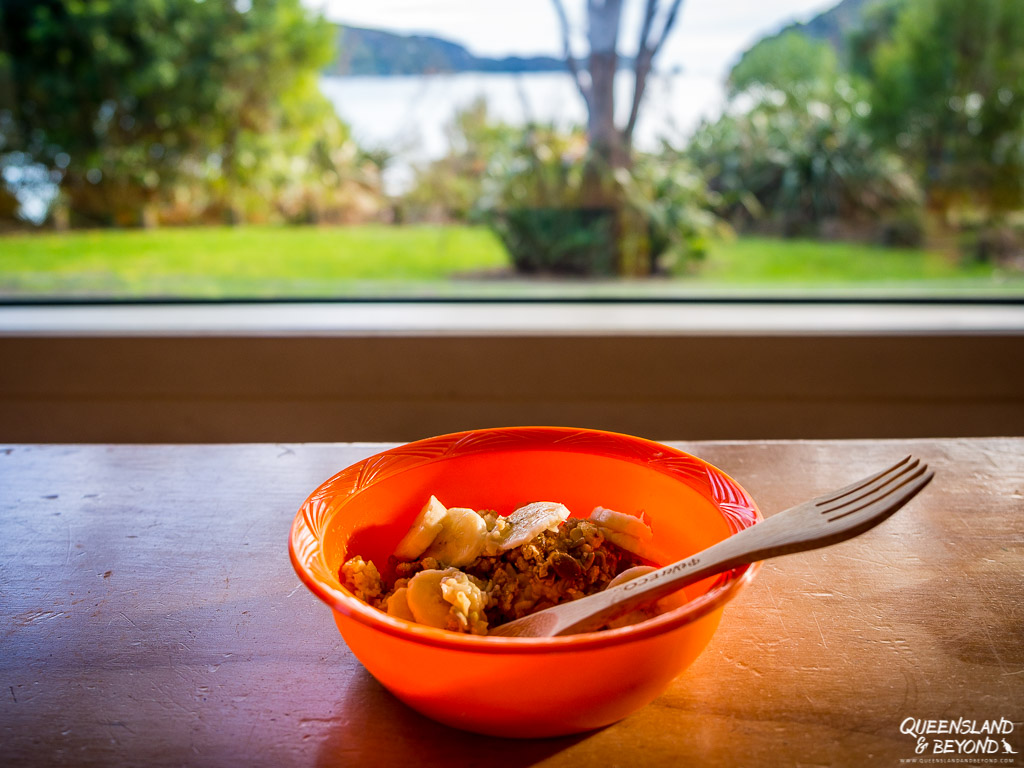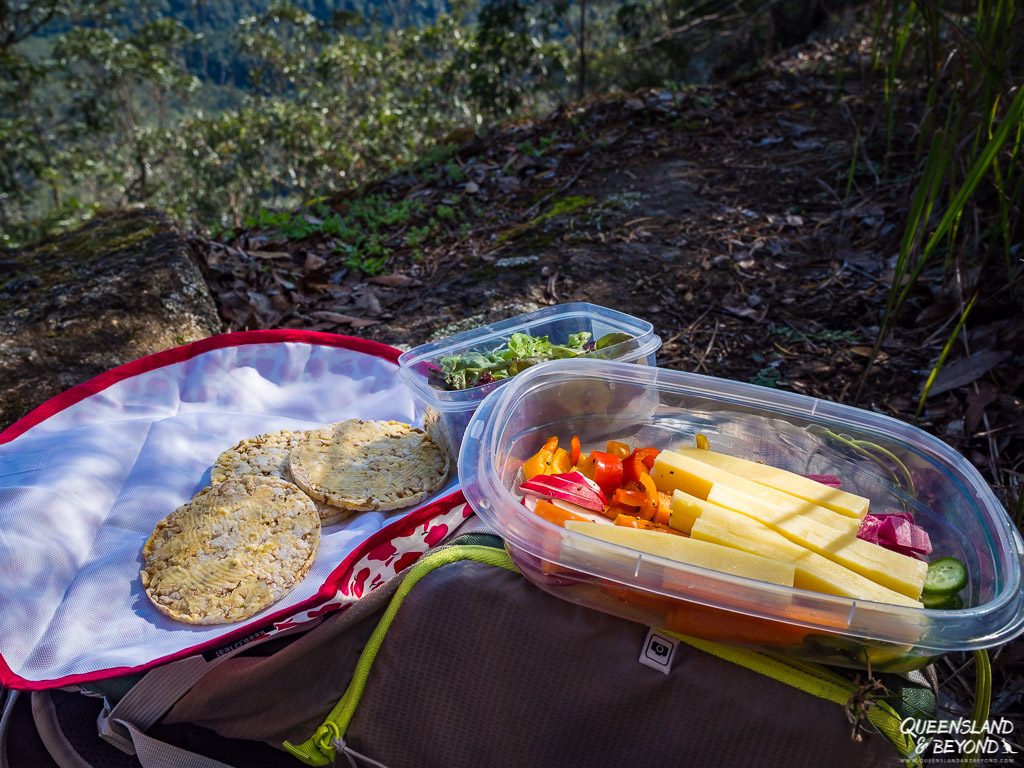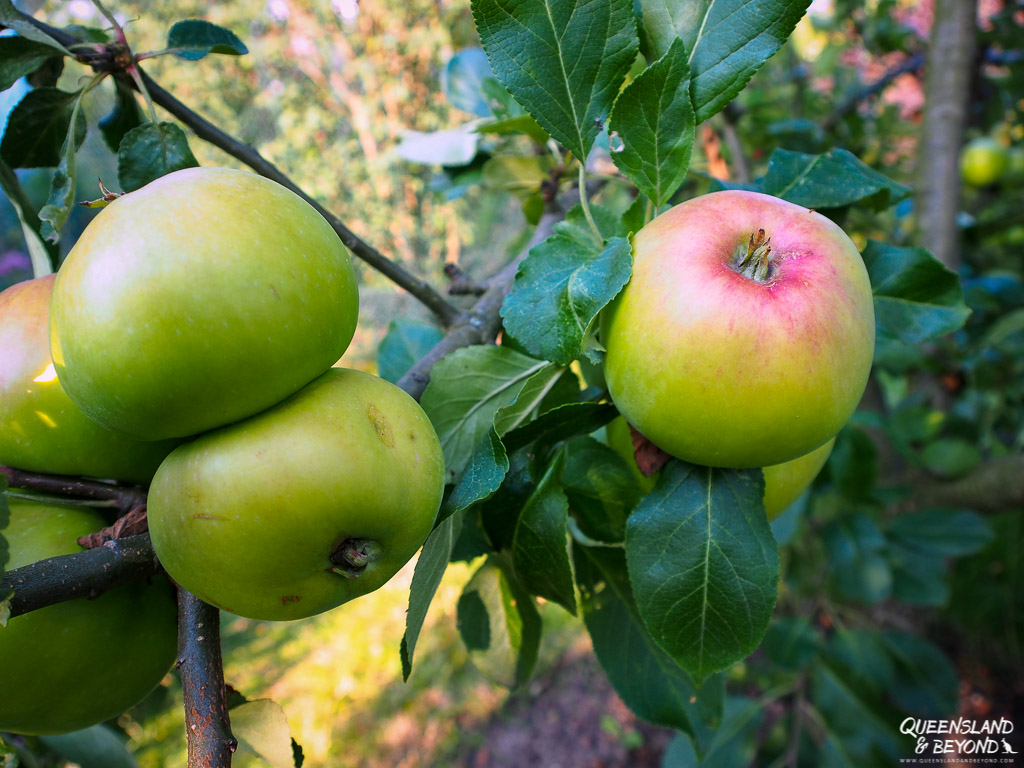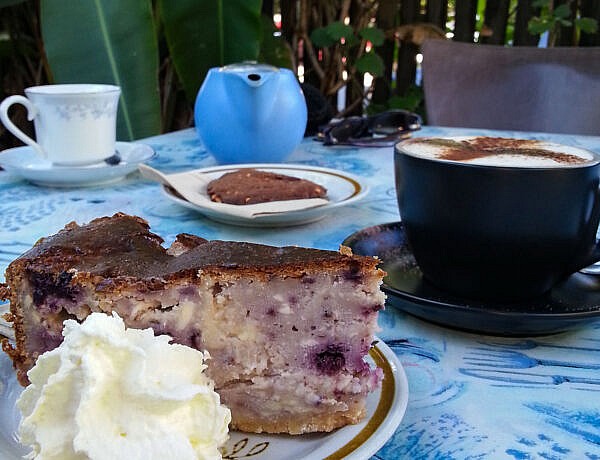When I was first diagnosed with severe gluten-intolerance several years ago, I was overwhelmed by the nutritional changes that lay ahead. I basically had to throw out my whole pantry and start afresh.
Gluten-free food has come a long way since then but the options are not always the healthiest. In fact, it can be very tricky to work out the best ones. This goes especially for hiking food and those times when you don’t have a full pantry or fridge next to you.
It’s taken me a few overnight hikes to fine tune my hiking diet so here’s what I survive on.

Products mentioned here are mostly from Australia but I will seek out similar ones when we travel overseas. Sometimes I bring products from home with me, just to make the first few days easier.
However, you need to be very aware of what you’re allowed to bring into other countries (check customs restrictions), and sometimes it’s just not possible to bring certain food items given food regulations.
That said, if you live in Australia (or New Zealand), you should have a pretty good grasp on what you can and can’t bring in. Australia is very strict on imported food but most people don’t realise that the majority of packaged food is fine, you just need to declare it (avoid dairy products though).
HIKING GLUTEN-FREE: A SIMPLE GUIDE
The last thing I want when I go hiking is to take a risk food-wise and be glutened accidentally. So I keep things fairly simple and trust some basic food choices.
It probably goes without saying that I only buy gluten-free products and read the labels carefully. Always.
BREAKFAST
Hikers often swear by porridge or oatmeal for breakfast given their protein content. And agreed, porridge makes for a nice warm meal, especially when the weather’s a bit on the cold side. Problem is… I don’t tolerate wheat-free oats very well, especially when there’s already some inflammation raging in my body.
In Australia, oats cannot be sold as gluten-free (though you will find pricey, imported ‘wheat-free’ oats in health food shops that I splurge on on occasion). Given that the gluten protein found in oats (‘avenin’) is similar in structure to that found in wheat (‘gliadin’), it’s no surprise that my body reacts with inflammation.
So, depending on the length of the overnight hike, I pick one of these gluten-free choices:
- Hard-boiled eggs (1-2 for one breakfast): Bulky but they’re full of protein and get me going in the mornings. I usually only take these for two to three-day hikes. If you’re hiking in cold or cool weather, you can probably take quite a few eggs if you’ve got the space.
- Gluten-free hot cereal, store-bought: I’ve tried a few, some are better than others. I measure out the quantity we need (usually 1 cup each) and store it in separate ziplock bags (one bag for each morning). We usually prepare the portion with water (not great, I know). In colder climates, you could take milk but we’ve never bothered. I try to add 1/2 banana to the cooked cereal, just to add a bit more flavour and substance.
- Bob’s Red Mill Mighty Tasty Hot Cereal is a bit gritty and not particularly tasty but it’s also probably the densest. You may be able to get Bob’s Red Mill products at Coles Supermarket but if not, most health food stores will have various Bob’s Red Mill products.
- Bob’s Red Mill Creamy Buckwheat Hot Cereal is another, though fairly bland, option. I don’t love it but it’s edible, especially with cinnamon and some banana.
- Orgran’s Quinoa Porridge is individually packed (‘meh’) and can get a bit mushy but it’s an alternative to corn-based hot cereal.
- In New Zealand, I tried Healtheries Wholegrain Hot Cereal, which was ok but not particularly tasty. If you add some dried fruit, banana or nuts, this is not a bad option though.
- Breakfast bar: If we have a very early start (I can’t eat too early in the morning), I often have a breakfast bar. They’re nutritionally not awesome but they help tie me over until I can stomach an egg or something else more substantial.
- Sanitarium used to make tasty gluten-free breakfast biscuits but, disappointingly, they’ve stopped. Now the only choice is Kellogg’s, which are way too sweet for my liking. I’m still hunting for better alternatives.

OTHER OPTIONS
If you don’t mind bringing milk or milk powder (or are happy to use water), gluten-free muesli or weetbix might make another good option. You can measure it out and only take what you need. I don’t really like cereal other than hot ones so I usually end up eating eggs or some sort of breakfast/protein bar.
I’ve seen some amazing breakfasts being cooked while hiking, most of which never occurred to me as we keep things as simple as possible. Some hikers bring cracked eggs in a jar (!) and then fry up scrambled eggs for breakfast. Amazing! I love scrambled eggs but I could never be bothered bringing a small frying pan (our billy wouldn’t really work for that).
LUNCH
Lunch tends to be fairly simple.
For two or three-day hikes, I cut up a range of vegetables and cheese for 2-3 lunches. For longer hikes, we eat vegetables + cheese for the first 2-3 days, then switch to a tuna + crackers diet for the remaining days.
I store everything in ziplock bags (and yes, I wash and reuse them) for multi-day hikes. For day hikes, we often just put it all in a container.
- Raw vegetable staples: Carrot, capsicum (pepper), cucumber; radish is another of my favourites but I don’t tend to use that for longer hikes (too fiddly); for day hikes, I may throw in some cherry tomatoes but not for multi-day ones as they just get squished and make a huge mess.
- Lettuce: On overnight hikes, we usually take cos lettuce because it lasts more than a day and can handle a bit of bumping around. You can also use cos lettuce as an alternative for corn thins.
- Cheese: Like the vegetables, I cut it up into sticks (I don’t buy pre-cut cheese as I find that a huge waste of money). Taking cheese is only good when it’s not too hot.
- Canned tuna/salmon: Especially for longer hikes, we take canned (or pouched) tuna, usually in oil or spring water as most of the flavoured ones have gluten additives.
- Salami: Not the healthiest but salami sticks are great for longer hikes. I don’t need to cut them up and they just give you an extra bit of protein help when you’re starving on a long hike. Read the label to check they’re gluten-free. Salami tends to be full of additives so you may not want to go crazy with the amount to take.
- Hard-boiled eggs: If I didn’t feel like eating my egg for breakfast, I usually have it for lunch. I don’t take extra eggs for lunch.
- Corn/rice thins: Part of our staple lunch diet (even at home). I pre-butter them (though not needed if you’re having them with tuna) and sandwich them together. We usually plan 2 corn thins per person for lunch so you do the maths. It can get bulky carrying x-number of crackers for several days, and they can break easily. So I always carry them at the top of my pack.
An alternative is to use cos lettuce leaves as your ‘open sandwich’. I don’t take gluten-free bread on hikes. It dries out and ends up being a crumbly mess.

DINNER
Dinner is even easier than lunch and incredibly simple.
After a long day of hiking, and our days are always long, the last thing I want to do is spend too much time cooking up a meal.
Plenty of hikers (especially in New Zealand, it seems) love the dehydrated hiking meals. They are ridiculously pricey in Australia, and most of them aren’t gluten-free. Or tasty for that matter.
So, we take two things for dinner:
- Pre-cooked rice: We use one pre-cooked rice pouch (e.g. Ben’s Original Rice Medley) between the two of us. On our last hike though, we found one wasn’t quite enough, and for our next hike, I’m going to trial 1.5 bags to see if that keeps me a bit fuller. We simply heat up the rice in the billy, which usually only takes a few minutes. Most of the flavoured pre-cooked rice products contain gluten so check labels carefully.
- A can/pouch of tuna: Once the rice is warmed up, we throw the tuna in and mix it all together.
And that’s dinner done.

SNACKS
Like with everything else, I try to keep things simple but I have been known to go overboard in the snack department.
- Fruit: Apples (1 per person per day), a few bananas (I only like them fairly hard), sometimes we also take some mandarins. No soft fruit (e.g. nectarines, strawberries) as they only end up making a huge mess.
- GF muesli bars: 1-2 per person per day, plus I throw in a couple of extra ones as my blood sugar can drop and a muesli bar can give me that quick fix I need.
- Chocolate: We usually take a block of dark chocolate that we snack on after dinner. Again, check the label to make sure it’s gluten-free.
- Nuts/dried fruit: Either pre-packaged or I make it up before we head off, using ziplock bags. I like almonds, walnuts, hazelnuts and dried apples (ideally without sulphites). And dried mango, but that can be pricey. Check for sugar levels and other additives.
- Lollies/sweets: Because I’m prone to low blood sugar, I can get a bit headache-y, and then feel nauseous, I always take some soft lollies (sweets) with me. They have done the trick of keeping me stable countless times.
Sometimes I manage to get some healthy(ier) options (I love Yum Earth). In general though, I am just careful to buy only those without sugar alcohols for sweetener (e.g. erythritol) as I can’t digest them and they wreak havoc on my digestion. Most of the time, I just buy whichever ones don’t have wheat syrup/gluten added, and check for which sweetener is used. Choices tend to be fairly limited and I just put up with any chemicals for the time being. I don’t really eat lollies when I’m not hiking so I’m not too concerned about the health impact here.

DRINKS
On our last hike in New Zealand, I rationed the tea bags so much that there wasn’t a chance either of us could have a spontaneous, additional hot drink! I just wanted to be efficient but went a little too crazy.
The husband and I do have a lot of hot drinks so if that’s not really your thing, your pack will be so much lighter, haha.
- Coffee: I avoid coffee but the husband has one every morning. We only do instant coffee on hikes so we measure out the coffee (more or less accurately) and carry it in a ziplock bag for a few days. For milk, we use milk powder or nothing.
- Tea: I’m a tea drinker, I can easily have 6-8 cups a day. I normally prefer loose leaf tea but that’s obviously way too impractical for hiking. So I pack 1-2 black tea bags, 1-2 green tea bags, 2 fruit tea bags for myself. The husband has the same, minus the green tea. I also throw 2-4 chamomile or ginger tea bags in, to help deal with any tummy issues or some anxiety that might creep up.
One of the fruit tea bags actually gets used for a thermos. It’s amazing how nice some hot or warm fruit tea is on a hike. Nobody wants to drink lukewarm black tea but even cold fruit tea still tastes great! - Hot chocolate: It can be really nice ending a hiking day with a hot chocolate, so when we do have some hot chocolate sachets, we’ll bring them along as well. It usually ends up one being shared between the two of us.
- Sugar: Well, again, in a ziplock bag, measure out what you need for drinks or to sprinkle on that bland gluten-free cereal.
- Vegetable/bone broth (Nutra Organics): I only tried this out on our last hike in New Zealand but the broth quickly established a firm foothold as a hiking staple. I mostly took it to help combat any nausea or upset tummy I might have but we ended up drinking it every night before dinner for extra fluid and as a warm-me-up drink. Plus, nutritionally, the Nutra Organics products are really fantastic!

WHERE TO BUY GLUTEN-FREE HIKING FOOD
AUSTRALIA
Your best options will be health food stores, they usually have an amazing range though can be very pricey. Coles and Woolworths supermarkets offer a fair few gluten-free options as well, both in the ‘health food’ aisle as well as mixed in with the standard products (e.g. you can find organic corn thins on the standard shelf). Aldi also has some less expensive gluten-free options.
For dehydrated gluten-free hiking meals, you’ll need to head to outdoor, camping or specialist hiking stores (e.g. Anaconda, Paddy Pallin, Tentworld, …).
NEW ZEALAND
When we go to New Zealand, we take the same approach as we do at home, heading to supermarkets such as Pak’n’Save or Countdown for general staples. Amazingly, a lot of the supermarkets also carry dehydrated meals! Speaks to the prevalence of the hiking culture, I guess.
CANADA
We mostly shopped at local supermarkets (e.g. Save on Foods in BC) with the odd health or organic food store thrown in.
GERMANY
I tend to shop at the larger supermarket chains (e.g. Real or Kaufland) and also chemist chains (e.g. DM or Rossmann) as they carry a huge range of health food. The supermarket chain REWE also has decent gluten-free options as do the pricier “Bio-Shops” like BIO Company, Alnatura or denn’s Biomarkt.
PERU
When I hiked across the Andes, I brought a lot of my own snacks and prayed that the food I would be given for lunch and dinner was really gluten-free (as requested). I didn’t get glutened so the 4-day hike ended up being a success!
A lot of the food I ate in Peru was naturally gluten-free, and to be honest, I worried more about getting travellers’ diarrhoea than getting glutened.
SUMMING UP
Sticking to a strict gluten-free diet on multi-day hikes, or even day hikes, isn’t too much of a challenge for me these days. I’ve got my staples sorted out for breakfast, lunch and dinner, and then just go hunting for some delicious snacks to throw into the mix.
If you need or want to avoid dairy and grains, omit the cheese (or choose a vegan option) and corn thins for lunch. Dinner will be more tricky, and I would either try one of the dehydrated meals or stick to a lettuce with tuna option.
MORE POSTS ON GLUTEN-FREE TRAVEL
Travelling to the Sunshine Coast in Australia? I’ve got a gluten-free guide on where to eat on the Sunshine Coast for you.
And if you’re headed to Europe, I’ve got a quick guide to gluten-free eating in Copenhagen, Denmark.
PIN ME






3 Comments
Spophy
21 August 2019 at 7:47 PMDas fand ich total spannend. Nicht mal von der glutenfreien Seiten her, sondern generell was ihr so beim Camping esst. Ich habe mir das ja etwas leckerer und üppiger vorgestellt, aber es ist wahrscheinlich besser bei solchen Trips praktisch zu denken ;D
Kati
27 August 2019 at 3:39 PMOh, hallo, hab voll vergessen zu antworten! 🙁
Haha, ja, so richtig aufregend ist die Nahrung beim Wandern eher nicht. Ich suche (und finde) natuerlich immer irgendwelche leckeren Sachen zum snacken, aber so fruehstuecks- oder abendbrotsmaessig ist das nicht sehr aufregend. 😀 Bei Mehrtageswanderungen geht’s wirklich ums Gewicht und Platz, und da muss dann der Naehrgehalt schon stimmen. Und wir haben ja auch nur einen kleinen Topf, mit dem man was aufwaermen kann, also koennen wir nur “one pot wonders” kochen. 🙂
Angie
23 October 2021 at 7:11 AMAwesome info. Thankyou. Heading to the bunya mountains. Nothing to strenuous there but not wanting to be in pain while walking. Limited with shops here out west so basic food it will be.